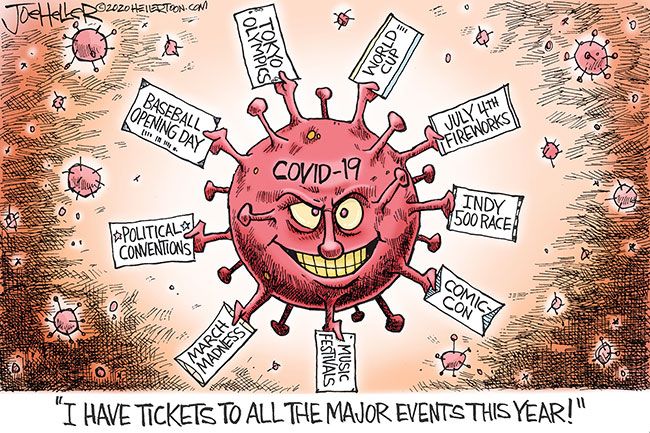Kirby Neumann-Rea: Obsolete optimism

The photo had likely been taken about 10 years ago: a case of the same thing, only different. Obsolete images on Google Earth are not uncommon, yet this one evokes the simultaneously static and dynamic sensations that can come with the passage of time.
If memory serves as a lookback at a picture of life in America six or more years ago, 2019 was more distinct to me than 2020, the year we typically think of as our clearest watershed.
As it unfolded, 2019 was typical. Come fall of that year, folks prepared for and anticipated the next year’s gatherings, vacations or projects, as well as patterns of work, school, church and social life. We knew 2020 would be a landmark, due to the presidential campaign, but by the time the pumpkins came off the porch, we had no real idea what was around the corner.
For 2020 would turn all things sideways, or inward on themselves, like the endless geometry in an Escher print. Is the stairway going up or down, sideways or inverted? How can things connect and divert at the same time?
My wife and I traveled back east in the fall of 2019. We discussed another such trip in 2020, and letters reflect plenty of hopes for travels to friends and family that year.
The 2020 we foresaw in 2019 would turn out nothing like we had expected, though. The fascination I find in 2019 is applying the retroscope to how we felt and thought during that year, not knowing what immense and often tragic change would dawn in December 2019, when the pandemic’s first hints emerged.
What was said or printed in early 2020 has to be viewed now through a revealing lens: In January and February, we were in a collective fog of foreboding newness, or denial, or both.
“It will be over in a few weeks.” Remember that mantra?
Still more poignancy can be found in what was written in that unwitting 2019. In retrospect, this makes it our most interesting year.
Call it obsolete optimism, but the July 14, 2019, special section of The New York Times read:
“The Next Giant Leap: Fifty years after Apollo 11, the full story of our relationship to the moon has yet to be told ...
“2017: the Year NASA planned the first test flight of its space launch system, which is intended to return astronauts to the moon. Its current target for a launch looks more like late 2020 or early 2021.”
So much for our cosmic expectations for what would become two troubled, deflating years.
I came to work at the New-Register in May 2021. In my desk was a repurposed file folder, dated Oct. 1, 2019, containing an order for an ad in the newspaper’s “Getaway Guide.” Looking back, I’m not sure how much any such guide got used.
The Corrections column in the April 4, 2020, Wall Street Journal categorized circumstance as error in saying, “The April issue of WSJ magazine (travel) went to press before the coronavirus pandemic led to widespread closures and cancellations.”
The year 2020 had not involved much “getting away.”
In the May 7, 2020, “Ziggy” cartoon, our hero is masked, as is the pharmacist, who extends a pill bottle on a gripper stick. Ziggy says, “I’ll sure be glad when social distancing is over.”
The cartoonist cannot be blamed for not knowing it was only getting started, though we now can ask the question, “Is this comedy or something based on reality?”
It brings to mind the lines from the old Faces song (later reprised by band frontman Rod Stewart): “I wish that I knew what I know now/when I was younger.”
On April 3, 2020, The Wall Street Journal called March 2020 “The Month That Changed Everything.” That feels clear now.
Henry Kissinger wrote in that edition,
“The reality is the world will never be the same after the coronavirus. To argue now about the past only makes it harder to do what has to be done.
“The crisis effort, however vast and necessary, must not crowd out the urgent task of launching a parallel enterprise for the transition to the post-coronavirus order.”
I don’t think even the likes of Dr. Kissinger knew the degree of truth in his foreboding words.
It’s an Escheresque traverse to ponder: Would we term the feeling, by mid-spring 2020, as, say, acceptance?
In The New Yorker of Dec. 28. 2020, Ian Frazier rhymed his annual holiday cultural roundup this way:
“Shout from the balcony or lawn,
“For joy at what will soon be gone,
“And praises sing for what is here:
“The end to this undreamt-of year! … “
Frazier is a comic genius, but here he is conveying some sense that with the advent of a new year, all this pandemic foolishness would also magically pass.
It would not and has not. Not fully.
I had also kept The New York Times’ “2020: Year in Pictures” special section
“Everyone was so hopeful and excited, making proclamations that 2020 was going to be their year,” wrote photographer Calla Kessler, on photographing New Year’s Eve at Times Square. “It just seems like a horrible joke now.”
Dean Baquet, executive editor of The New York Times, wrote, “No one could escape the virus and vitalness of 2020.”
That’s certainly one way to put it.









Comments